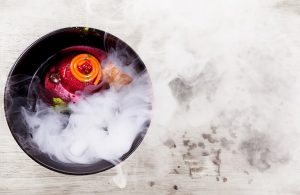Molecular gastronomy is a perfect amalgamation of scientific fields. This is a modern cooking method based on physical and chemical changes and molecular structure to create dishes with high nutritional value.
Pioneers
The term “Molecular and Physical Gastronomy” was first used by Hungarry physicist Nicholas Kurti and French chemist Hervé This in 1988. Four years later, it became the subject of a series of seminars held. office in Erice, Italy. In this event brought scientists and chefs together to discuss the impact of science on traditional cooking and agreed to shorten the original term to “Molecular Cuisine”.
What is molecular gastronomy?
Molecular Gastronomy – is taking advantage of modern technology and chemical – physical transformations, thereby affecting and changing the molecular structure of ingredients to create a completely different form for the dish. Thus, with this new form of expression, Molecular Cuisine presents before your eyes an extremely beautiful and delicate dish, but hidden inside is a wonderful and wonderful processing process from the combination of Chemistry – Physics – Food creates.
Typical techniques of molecular gastronomy
Sous -Vide
Food will be cooked in a vacuum sealed plastic bag and submerged in water of the right temperature for a long time. Food prepared in this way cooks very evenly. There are dishes that are processed very carefully when kept in a bag with a temperature of 70 degrees Celsius for 2 days in a row.
Flash Frozen
Instantly freezes foods while preserving their structure perfectly.
Faux Cave
This method is intended to create a solution in the form of a liquid colloid. Ingredients are usually extracted from brown algae or a combination of olive oil, tea and fruit juice creates small balls that look like caviar. The liquid is held in place by a thin, hard gel film, inside which is water, which does not melt.
Deconstruct
Dishes made with this technique will have ingredients that are completely separate instead of combined. When enjoying the food, you will feel 100% of the flavor of each ingredient to the fullest.
Edible Paper
“Edible paper” is made from potato pulp, soybeans, and color essences obtained from fresh fruits. These sheets can be printed on and of course they are edible.
In molecular cuisine, the ingredients will be interfered with by the chef to change the taste and shape to create the most unique and novel experience for the taste buds. The chef is compared to a scientist, an artist, a real magician.
